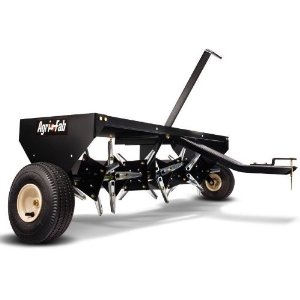
Lawn aerators come in many forms. Homeowners who have large lawns often find that a "pull behind the lawnmower" model works just fine for their needs.
If you have a large lawn, the very best type of lawn aerator that you can use is a mechanical coring lawn aerator.
The best professional brands are ones with their own gas engines, but most homeowners can get by just fine with a tow behind model.
If your lawn is small, or you only have a few small trouble spots where the grass does not want to grow, you can find manual lawn aeration devices.
These manual lawn aerators have a handle and give you the ability to pull two or four plugs out at a time. There are even models that you can strap onto your shoes and walk around your yard pulling out small plugs of sod.
This works amazing. For best results, or if you haven’t aerated in a few years, I recommend that you go over your entire lawn with the lawn aerator twice.
If you have short grass, you will want to break up the plugs. If you have tall grass, you can just leave the plugs where they are and should not really have to worry about breaking them up.
After aerating is the best time to put down your fertilizer. If your lawn is sparse, you may also consider overseeding, especially if you are able to water your lawn on a regular basis and thereby improve your aeration results.
Why does lawn aeration help?
Any good aerator pulls plugs of sod out of your lawn leaving holes which helps the fertilizer, water, and other natural nutrients reach the roots of your grass, loosens up hard packed soils, and generally makes it easier for the roots of your grass to spread.
When is the best time to aerate your lawn?
Lawn aeration is most effective when it is done in the spring or the fall. It just depends what time of year your grass goes yellow.
If it goes yellow in the summer, think about having it aerated in the spring. If it goes yellow and dormant over the winter, think about having it aerated in the fall. If it goes dormant both in the fall and in the winter, you may want to consider having it aerated twice.
How often should you aerate your lawn?
You also will want to consider having your lawn aerated twice a year if you live in a mountainous area, or if your soil contains a lot clay. The disadvantage of having clay soil is that it gets mushy when it rains, and it gets hard, compacted and dry easily only a few days after it stops raining.
In order to retard this process, it is a good idea that you consider having your lawn aerated. This will give your clay soil room to expand, and also allow it to absorb more of the water down to the roots of the plant where it is needed most.
The end goal with aerating your lawn on a regular basis is that eventually you have a thicker and healthier turf with a lot of organic material in it, and then you only need to have your lawn aerated once every three or four years.

